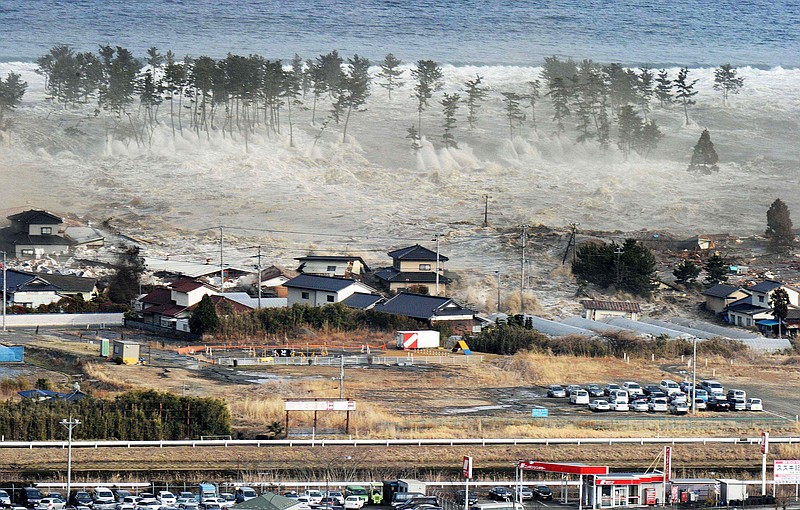TOKYO — A ferocious tsunami spawned by one of the largest earthquakes on record slammed Japan’s eastern coast Friday, killing hundreds of people as it swept away ships, cars and homes while widespread fires burned out of control.
Hours after the quake, the waves washed ashore on Hawaii and the U.S. West coast, where evacuations were ordered from California to Washington but little damage was reported. The entire Pacific had been put on alert — including coastal areas of South America, Canada and Alaska — but waves were not as bad as expected.
In northeastern Japan, the area around a nuclear power plant was evacuated after the reactor’s cooling system failed and pressure began building inside.
Police said 200 to 300 bodies were found in the northeastern coastal city of Sendai, the city in Miyagi prefecture, or state, closest to the epicenter. Another 151 were confirmed killed, with 547 missing. Police also said 798 people were injured.
Click here to watch our extensive video coverage of the quake and tsunami.
RELATED CONTENT
- LATEST VIDEO
- http://www.arkansas…">Quake felt on Arkansas sensors
- http://www.arkansas…">LATEST NEWS
- http://www.arkansas…">Diamond Hogs, in Cali, not affected
- http://www.arkansas…">Waves hit U.S. West Coast
- http://www.arkansas…">Obama: Japan quake potentially ’catastrophic’
- http://www.arkansas…">Nuke plant system failure evacuates 3,000
- http://www.arkansas…">Quake causes day to get shorter
- http://www.arkansas…">59 Japanese students at ASU try to reach kin
The magnitude-8.9 offshore quake triggered a 23-foot tsunami and was followed for hours by more than 50 aftershocks, many of them more than magnitude 6.0. Then, in the early hours of Saturday, a magnitude 6.6 earthquake struck the central, mountainous part of the country — far from the original quake’s epicenter. It was not immediately clear if this latest quake was related. t caused buildings in Tokyo to sway. There were no immediate reports of damage.
Friday’s quake shook dozens of cities and villages along a 1,300-mile stretch of coast, including Tokyo, hundreds of miles from the epicenter. A large section of Kesennuma, a town of 70,000 people in Miyagi, burned furiously into the night with no apparent hope of being extinguished, public broadcaster NHK said.
Scientists said the quake ranked as the fifth-largest earthquake in the world since 1900 and was nearly 8,000 times stronger than one that devastated Christchurch, New Zealand, last month.
As night fell and temperatures hovered just above freezing, tens of thousands of people remained stranded in Tokyo, where the rail network was still down. The streets were jammed with cars, buses and trucks trying to get out of the city.
The city set up 33 shelters in city hall, on university campuses and in government offices, but many planned to spend the night at 24-hour cafes, hotels and offices.
Japan’s coast guard said it was searching for 80 dock workers on a ship that was swept away from a shipyard in Miyagi.
Even for a country used to earthquakes, this one was of horrific proportions because of the tsunami that crashed ashore, swallowing everything in its path as it surged several miles inland before retreating. The apocalyptic images on Japanese TV of powerful, debris-filled waves, uncontrolled fires and a ship caught in a massive whirlpool resembled scenes from a Hollywood disaster movie.
Large fishing boats and other vessels rode high waves ashore, slamming against overpasses or scraping under them and snapping power lines along the way. Upturned and partially submerged cars bobbed in the water. Ships anchored in ports crashed against each other.
The tsunami roared over embankments, washing anything in its path inland before reversing directions and carrying the cars, homes and other debris out to sea. Flames shot from some of the homes, probably because of burst gas pipes.
Waves of muddy waters flowed over farmland near Sendai, carrying buildings, some of them ablaze. Drivers attempted to flee. Sendai airport was inundated with thick, muddy debris that included cars, trucks, buses and even light planes.
Highways to the worst-hit coastal areas buckled. Telephone lines snapped. Train service in northeastern Japan and in Tokyo, which normally serve 10 million people a day, were suspended, leaving untold numbers stranded in stations or roaming the streets. Tokyo’s Narita airport was closed indefinitely.
Japanese automakers Toyota, Nissan and Honda halted production at some assembly plants in areas hit by the quake. One worker was killed and more than 30 injured after being crushed by a collapsing wall at a Honda Motor Co. research facility in northeastern Tochigi prefecture, the company said.
NHK said more than 4 million buildings were without power in Tokyo and its suburbs.
The quake struck at a depth of six miles, about 80 milesoff the eastern coast, the agency said. Several quakes hit the same region in recent days, including one measured at magnitude 7.3 on Wednesday that caused no damage.
A tsunami warning was extended to a number of areas in the Pacific, Southeast Asia and Latin America, including Japan, Russia, Indonesia, New Zealand and Chile. In the Philippines, authorities ordered an evacuation of coastal communities, but no unusual waves were reported.
Japan lies on the “Ring of Fire” — an arc of earthquake and volcanic zones stretching around the Pacific where about 90 percent of the world’s quakes occur, including the one that triggered the Dec. 26, 2004, Indian Ocean tsunami that killed an estimated 230,000 people in 12 nations. A magnitude-8.8 temblor that shook central Chile in February 2010 also generated a tsunami and killed 524 people.
